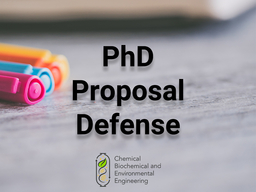Ethan Hain : PhD Proposal Defense
FORMAT: VIRTUAL PRESENTATION
Location
Online
Date & Time
August 10, 2020, 9:00 am – 12:00 pm
Description
Occurrence and toxicity of contaminants of emerging concern in the Chesapeake Bay
Ethan Hain, PhD Student
Advisor: Dr. Lee Blaney
ABSTRACT:
The environmental occurrence of contaminants of emerging concern (CECs) can lead to antibiotic resistance, endocrine disruption, and other toxicity endpoints. Our previous work at a limited number of sites in the Chesapeake Bay demonstrated that antibiotics were present at levels capable of selecting for antibiotic resistant bacteria; furthermore, UV-filters, which are the active ingredients in sunscreens and other personal care products, were consistently detected in water, sediment, and oyster tissue. The principal sources of CECs are expected to be agricultural (e.g., animal feeding operations) and urban (e.g., septic systems, wastewater treatment plants) discharges; however, source identification remains a challenge. In the present work, we deployed two strategies to inform CEC sources. First, the dissolved organic matter (DOM) of water samples was characterized by absorbance spectra and fluorescence excitation-emission matrices. The DOM fluorescence signatures were modeled as specific components using parallel factor analysis, and those components were used to characterize DOM by source. Second, novel methods were developed to quantify chemical indicators of agricultural and urban discharges in water and sediment. Those methods were applied to measure 2 agricultural and 5 urban indicators, as well as a large suite of CECs consisting of 37 antibiotics, 9 hormones, and 13 UV-filters, in 50 sediment and 93 water samples over two years; furthermore, 27 of the most hydrophobic CECS were also analyzed in 88 oyster samples. The relationships between fluorescent components, agriculture indicator species, wastewater indicators, CEC concentrations, and land-use characteristics will be explored to develop effective tools for identification of contaminant sources in Chesapeake Bay river systems. In this ongoing work, UV-filters were found to be ubiquitous in the Chesapeake Bay. Based on this result and current toxicity concerns about UV-filters in other aquatic organisms, we plan to investigate the effects of UV-filters on Thalassiorsira pseudonana, a keystone algal species in the Chesapeake Bay. With this comprehensive approach to understanding CEC occurrence, sources, and toxicity, I aim to inform the environmental risk of CECs for stakeholders in the Chesapeake Bay watershed. .
Agenda:
8:45 am: Meeting room will open 9:00 AM: 1 hr presentation will be open to the public with Q&A. Followed by a closed session with the committee and PhD Student.Meeting link:
